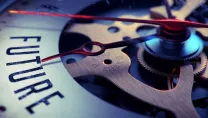Sport as entertainment works on many levels. At one end of the spectrum there is a pure and simple experience: the excitement, the action - the struggles, highs and lows of ‘your’ team. You can enjoy that anywhere.
But with a little help from state-of-the-art interactive display technology, Sky Sports has created a whole new experience with inside knowledge and expert opinion that creates a richer, deeper experience, which informs as well as entertains.
“With a modern, high quality touchscreen you can replay the action and have guest pundits pausing it to explain what’s going on (or going wrong); drawing and writing on the screen to illustrate their views,” explained Sky Sports Technical Manager, Brian Naylor.
“The new model has very precise and predictable touch inputs. Up to four people can draw on it at the same time, and you can move the user interface to the most convenient area of the screen. There are controls to adjust the colour balance and it’s tough enough to use on location.”
Leading the way with large format interactive flat panel displays
Because Sky Sports was such an early adopter of large format touchscreens it faced a number of challenges.
“When the first large touchscreens came to market about five or six years ago, we immediately realised their potential,” said Naylor. “But they were clearly designed for offices and boardrooms. A studio environment is completely different.”
In the early days, there were three main issues to overcome: false touch inputs, a different colour balance and portability. These were common to every brand that Sky tested.
The false inputs – entirely unacceptable on live TV - were caused by powerful studio lighting. Careful experimentation with different lighting setup yielded the solution. But the colour balance presented a trickier challenge.
Sky wanted to be able to film the touchscreen being used by guest pundits to replay action sequences, drawing on the screen to share their thoughts. The director would then cut back to the live action. But touchscreens have a different colour balance to TV cameras – enough to be noticeable to the viewer.
“In those days we could only solve this by tweaking the technology,” he said. “That meant degrading the performance a little but at least we were able to cut to the live action without a distracting change in colour temperature.”
The third problem was portability and fragility. The first touchscreens were designed to be fixed in a single office location. Many of them still are. So Sky engaged the services of a specialist company to move its screens to external locations when needed. This practice continues today but now it is a matter of convenience rather than one of necessity.
“Sharp’s BIG PADs have four carrying handles built in to the sides. I haven’t seen that in other makes. Clearly, Sharp is happy for these to be moved around from place to place. That’s impressive,” commented Naylor.
This toughness and reliability is important to Sky. Sometimes, the equipment has to be loaded, transported, unloaded and rigged in the space of a day, leaving little margin for error. That was the case with the Liverpool Vs. Manchester United game, where the BIG PAD was transported to Anfield and used lying flat, like a table, allowing the Stadium to be seen in the background.
“We had nearly 3 million viewers for that one,” said Naylor. “As expected, there were no problems. It went in, it worked, and it did the job we asked of it.”
“Sky Sports uses the BIG PADs extensively – every day. Of course, I keep a close eye on the market but, so far, I haven’t discovered anything that is better than the BIG PAD. It gives me the best performance, the greatest versatility, the most sensitive inputs and it has a rugged, but attractive design,” said Naylor.
“In live TV, just as in sport, sometimes you only get one shot. It’s part of my job to make sure that we never miss.”
To find out more about the Sharp BIG PAD range of interactive displays, Get in Touch to arrange a demonstration for your business.




